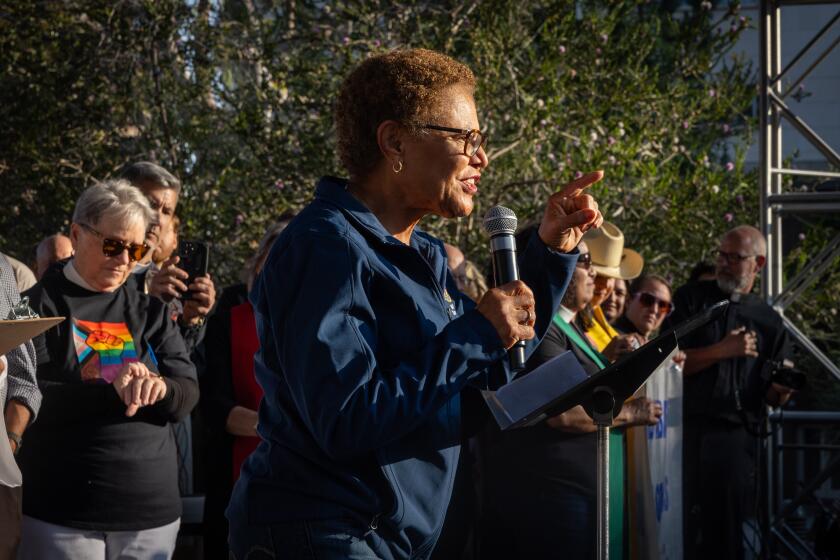Angelenos Talk Over Differences
- Share via
At a Highland Park fire station, the dialogue on race jumped off with a problem posed by an elderly white man who felt his Latino neighbors were not friendly.
Bob Corwin said he took them avocados from his tree, even gave them fancy candy from the store, but nothing helped.
“They don’t open up to me,” he said. “When I walk up, they are like turtles going back in their shell.”
That was more than Dora Palacio, another longtime resident, could take.
“You don’t have to buy them candy, just say hi!” she said.
The firehouse exchange was just a slice of the two-hour discussion organized by Days of Dialogue, an group dedicated to bringing together Angelenos of various racial and ethnic groups to talk openly about race.
The idea behind Days of Dialogue is simple: The more people talk about their differences, the more they understand one another.
So organizers of this year’s nonprofit experiment in human relations set out to muster as many people as they could to talk about race over the two weeks leading up to the Martin Luther King Jr. holiday. Sixty dialogues were organized across the city, from San Pedro to South-Central and East Los Angeles, Granada Hills to Venice.
“We wanted to create an environment for people who would not normally talk about such powerful issues to do so,” said City Councilman Mark Ridley-Thomas, who came up with the idea for the dialogues in 1995 after the O.J. Simpson verdict exposed a bitter racial divide.
This year, more than half of the dialogues were held in fire stations in an effort to encourage more grass-roots involvement and bring firefighters closer to the communities they serve, said Karen Mack, a Days of Dialogue board member.
Although most of the dialogues touched on race, this year’s discussions were broadened to allow groups to include the topic of building strong neighborhoods.
“We have discussed race; now we need to focus on how to make things better,” said Cherie Wilson, a dialogue moderator.
At the Highland Park fire station, firefighters urged the residents to remember to include them in neighborhood activities.
“We are open 365 days a year and we are part of the community,” Capt. Jerry Thomas said.
Other groups took the discussions in many directions.
A dialogue held at a San Pedro drug rehabilitation center focused on how the port has changed over the years. In Pico-Union, residents talked about the impact of street vendors on local merchants. A senior citizens center in the Crenshaw district invited children from a local elementary school to its dialogue.
At the Crenshaw center, Jim Safford, a 69-year-old retiree, complained that the dialogue was basically among African Americans and lacked the participation of other ethnic groups.
“If a dialogue is going to bring people together, you need to hear from other groups,” he said.
At the Martin Luther King Jr. Dispute Resolution Center in South-Central Los Angeles, the more than two dozen participants varied in age and ethnic backgrounds.
Henry Shin, a 16-year-old University High School student, said that many older Korean Americans, like his parents, have “lost confidence” in the system since the 1992 riots.
“They are afraid,” he said. “They don’t vote.”
Seated across the table, Nareshima Osei, an African American community activist, spoke of a history of tensions among blacks and Asians and Latinos.
“Sometimes I feel stuck in the past,” he said, adding that the next generation would provide hope.
At another gathering in South-Central, African American and Latino teenagers exchanged views not about race, but about their fear of gang violence.
“The people who are the problem are not here and they won’t come,” said one.
“If they won’t come, then we should go and talk to them,” said a 12-year-old.
At a Mid-City fire station, an elderly man sparked a lively discussion after he complained that he was unable to get his Latino neighbors involved in community activities. He said that some new immigrants keep live chickens and hang clothes outside to dry.
“They don’t understand how we live,” he said.
The use of the word “they” touched a raw nerve.
“It’s individuals you are talking about, not groups,” said Roderick Sykes, the director of St. Elmo Village, an artists’ community.
“There were probably meetings like this with white people saying the same thing about us when we moved into the community,” he said. “People forget.”
More to Read
Sign up for Essential California
The most important California stories and recommendations in your inbox every morning.
You may occasionally receive promotional content from the Los Angeles Times.













